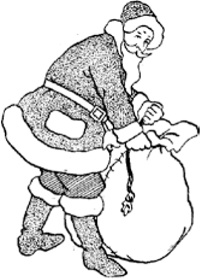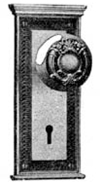Now I Know More (14 page)
Authors: Dan Lewis


WHY THE U.S. GOVERNMENT TRACKS SANTA'S MOVEMENTS
Every Christmas Eve, children around the world wait for a visitor to arrive through the chimney via reindeer-drawn sleigh, or whatever other means of entry and travel local custom dictates. Santa exists in the hearts and minds of these children. And they like to keep tabs on the jolly man in the red suit. They write him letters at his North Pole address starting in November or December, of course, but there's more that they can do. Since Christmas Eve 1955, children call up the United States military to ask for his current location because the North American Aerospace Defense Command (NORAD), headquartered in Colorado, tracks St. Nick's every move that night. They now have a website,
www.noradsanta.org
, set up for the event, and even make faux videos of Santa delivering gifts on his tour around the globe.
Even though the “tracking” is only slightly more real than Santa himself, this seems like a strange use of multibillion-dollar defense technology and associated personnel. After all, NORAD was a Cold War creation, aimed at defending the U.S. and Canadian airspace from Soviets, not Santas. How did it get in the business of tracking reindeer? Easily: just start with a typo, and add a military officer with a good sense for making kids smile.
On Christmas Eve 1955, Sears ran an advertisement in a newspaper in Colorado Springs, Colorado. The advertisement invited children to call Santa, “direct,” on his “private phone,” “any time, day or night.” Many children took up the invitation, the first one being a young girl.
The man on the other end of the phone wasn't clad in red. The phone, however, was. The phone number in the advertisement was incorrect, and instead of calling the Sears Santa Hotline, as Mentalfloss reports, the child had called a phone at NORADâand not just any phone. The number led to a red emergency phone typically reserved for incoming messages from the Pentagon or other higher-ups in the military.
The colonel in charge, Harry Shoupâonce he figured out that it was a wrong number and not a prankâplayed along. He told the young caller that he was, indeed, Santa (sometimes it's okay when members of the military lie to citizens) and asked her if she had been good. The two spoke a bit furtherâabout cookies and reindeer, of courseâand then Santa Shoup and the girl both hung up.
Then the phone rang again. It wasâagainânot the Pentagon.
Shoup took the initiative and assigned others to man the phone, speaking to the callers as Santa. The goodwill gesture resonated throughout NORAD's halls and became an annual tradition. Every year, hundreds of volunteers man the phones (and now, e-mail), answering when children call. According to the
Huffington Post
, volunteers are given an “11-page playbook [that] includes a list of nearly 20 questions and answers, including how old is Santa (at least 16 centuries) and has Santa ever crashed into anything (no).”
Want to write a letter to Santa? You canâand you'll probably get a reply. After receiving a lot of letters for the jolly man in the red suit in 1974, members of Canada Post's Montreal office decided to write back, hoping to keep children from being disappointed. In 1983, Canada Post took the program national, establishing a program to reply to all letters addressed to Santa. To streamline the processâwhich, given the million-letter volume, is necessaryâCanada Post set up a special mailing address. You can write to St. Nick at “Santa Claus, the North Pole, Canada,” with postal code H0H 0H0.

THE AMERICAN JETS SENT OFF TO FIGHT WORLD WAR III
The Cuban Missile Crisis began on October 14, 1962, when the United States obtained photographic evidence of a Soviet nuclear missile installation in Cuba. For nearly two weeks, the world was on the brink of nuclear war. The U.S. military went to high alert. Any action on either side of the conflict could have resulted in mutually assured destruction, as both militaries and their nuclear arsenal were at the ready.
On the night of October 25 and into the next morning, that nearly happened. Nuclear-armed U.S. jet planes were ordered to the skies to intercept incoming Soviet bombers. They thought the Soviet Union had started World War III.
Late that evening, around midnight, a would-be intruder attempted to gain access to a military base in Duluth, Minnesota. The base was one of a handful that held a large computer network called the SAGE systemâSemi-Automatic Ground Environmentâwhich collected and reconciled radar data to give military officials a single image of the region's airspace. Using this information, officials could coordinate a response in case of a Soviet air assault. Had the Soviets gained access to the Duluth base and sabotaged the computer network, parts of the U.S. military operations would be flying blind.
The intruder did not make it into the Duluth base. A sentry noticed him climbing the fence and shot him, incapacitating the apparent Soviet saboteur. For reasons unreportedâgiven the global situation at the time, this was prudentâthe guard sounded the alarm signaling a sabotage attempt. The alarm system was designed to sound in bases throughout the region if not the entire United Statesâafter all, if the Soviets were taking a crack at one base, there's a good chance others were immediately at risk as well. If things went right, many U.S. bases would, once the alarm sounded, run a security sweep for possible breaches.
Unfortunately, things went wrong. At Volk Field in Wisconsin, something was amiss with the alarm wiring. The alarm that sounded wasn't the one signaling a possible saboteur. Instead, it was the one telling nuclear-armed jet fighters to take to the skies. This wasn't a drill, eitherâthe policies at the time did not allow for such practice runs when on such high alert, as to avoid ambiguity. As far as Volk Field's personnel believed, World War III had begun. To make matters worse, because of the activity in Cuba, the military had sent nuclear bombers into patrol, some near Volk Field. Had the interceptors ever taken flight, there's a good chance the American fighters would have shot down their own nuke-laden bombersâand above U.S. soil.
The planes, however, never took off. An official raced from the command center to the runway, probably while the jet fighters were still doing their pre-flight checks, to inform them that it was a false alarm. Not only had the wrong alarm sounded at Volk Field, but there was no saboteur in the first place. The man who tried to invade the Duluth base wasn't a saboteur or a Soviet, or for that matter, a man.
It was a bear.
In 2008, a beekeeper in Macedonia noticed that his hives were being attacked by an unknown invader. The culprit, taking a page from Winnie the Pooh's playbook, turned out to be a bear looking for honey. The beekeeper, though, wanted to be compensated for the bear's damage, so the local government pressed criminal charges against the bear, according to the BBC. The bear was convicted in abstentia (officials couldn't locate the bear to arrest him). Because the animal had no owner, the beekeeper was able to collect damages from the local government, totaling about $3,500.

WHY DOORKNOBS ARE BEING BANNEDâ EXCEPT IN PART OF COLORADO
In 1999, the U.S. Small Business Administration and the Department of Justice teamed up to provide a guide for small businesses, helping them comply with the requirements of the Americans with Disabilities Act (ADA). Among the suggestions is a subsection dealing with “architectural barriers”â“physical features that limit or prevent people with disabilities from obtaining the goods or services that are offered.” Of specific note are round doorknobs, as they may be difficult for some people to grip and turn, thereby preventing access to whatever's on the other side. In late 2013, Vancouver (Canada) echoed its neighbors to the south and banned round knobs on doors on any new housing built within its borders. If you want to respect those who are differently abled, you may want to go with lever-like handles instead. As
Popular Science
argued, they're “the way of the future.”
Just don't tell that to the people of Aspen, Colorado. Because in many parts of that area, not only are round doorknobs allowed; they're required by law.
The reason? Bears.
Aspen is the largest town in Pitkin County, with just under 9,000 full-time residents. That constitutes roughly half of the county's populationâbut only if you count people. Due to the large amount of forest in the area, Pitkin County is also home to 5,000â10,000 black bears.
The bears eat about 20,000 calories a day during the summer and autumn months as they prepare for hibernation, and when it comes to a meal, they're not all that picky. Often, a bear will wander into town in search of food, and let's face it, we humans do a great job of leaving snacks out. Unsecured garbage cans, uncleaned barbecues, and birdfeeders are specifically mentioned by the Aspen authorities as open invitations to a foraging bear. In fact, from April 15 to November 15âthat's bear seasonâa city ordinance specifically prohibits residents from using birdfeeders.
As of the summer of 2010, doorknobs also fell under a bearcontrol ordinance. There were a few instances of bears entering people's homes and businesses, not understanding that it was inappropriate to do so; bears shouldn't be expected to know that breaking and entering is both illegal and impolite. Levers, as the ADA compliance guide notes, are easier to open for people who can't grip and turn things. Bears lack opposable thumbs and, therefore, find levers much easier to open than they do the classic doorknob. So the Pitkin County government, as the Sky-Hi News reported, passed a law that “requires solid, round-handled doorknobs rather than the lever variety on exterior doors on all new homes” in the areas near bear habitats.
The rule had its skeptics and dissenters, of course. Some saw it as governmental overreach, while others pointed out that the bears could often flatten the knobs or just smash down doors. (They're bears, after all.) But don't worry about any issues regarding ADA compliance. The Sky-Hi News assures that “exemptions are made for doors that must meet disability standards.”
Ever notice that many doorknobs are made of brass or copper? There's a reason for that. Those types of metals are poisonous to many types of household germs (although we don't yet have a good explanation as to why), and doorknobs made of those materials disinfect themselves slowly over the course of about eight hours.
